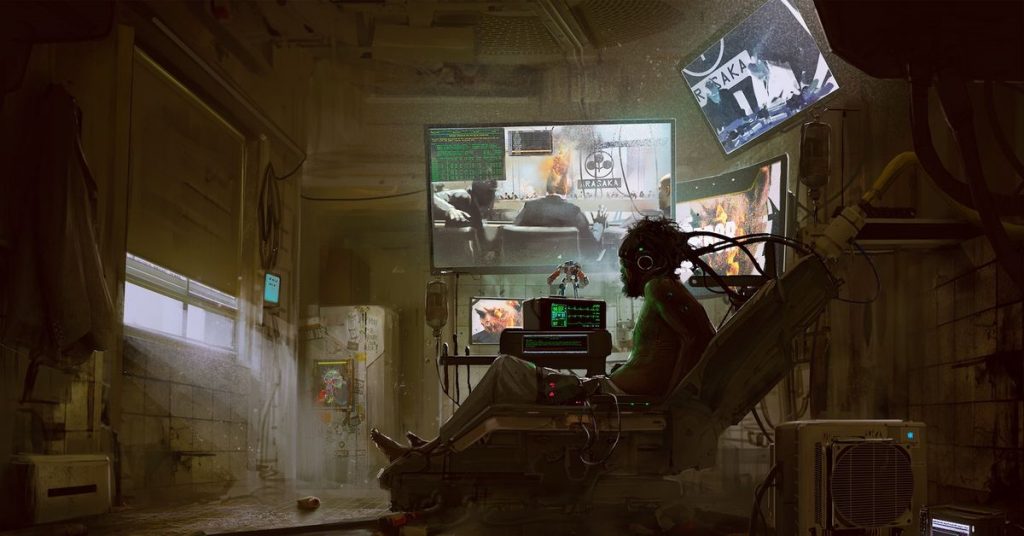What is cyberpunk?
A woman doing her makeup as the camera slowly pulls out to reveal she’s missing the bottom half of her face, a gaping cybernetic maw in its place. A cable jacked directly into a businessman’s skull, sparking and smoking as it fries his brain. An elevator the size of an apartment, crawling up the side of a high-rise towards the sky.
These are just some of the fragmented vignettes studio CD Projekt Red put on display in Cyberpunk 2077’s debut trailer earlier this year. As an introduction to Night City, it promised one of the most distinctive game settings since Rapture or City 17 — but not much of its neon-soaked imagery is original. And that’s by design.
With this game, CD Projekt Red is drawing from a long tradition, one that — unusually — is named right there in the title: cyberpunk. But what exactly does that mean, and where did it come from?
Before “cyberpunk”
You can trace the roots of cyberpunk back through multiple generations, but the first definite milestone in its development was the book Do Androids Dream of Electric Sheep? Philip K. Dick’s 1968 novel introduced the world to Rick Deckard, a bounty hunter tracking down a gang of escaped androids trying to pass as humans.
If that sounds familiar, it’s because the book was adapted, over a decade later, into Blade Runner.
The movie’s night-drenched cityscape, lit by plumes of flame from industrial towers and skyscraping video billboards, set the visual template for most cyberpunk going forward.
But that world didn’t come from Dick’s novel as much as it did The Long Tomorrow, a 1975 comic by French artist Moebius and screenwriter Dan O’Bannon. Moebius’ conception of a grimy future city, where tightly-crammed tower blocks form a deep chasm around its inhabitants, inspired not only director Ridley Scott, but also Katsuhiro Otomo — whose Akira manga began publication in Japan in 1982, the same year as Blade Runner’s release — and an American-Canadian novelist named William Gibson. But we’ll get back to him.
The naming of a genre
Between Do Androids Dream of Electric Sheep?’s questions about who counts as human in an age of androids, The Long Tomorrow’s blending of film-noir tropes and science fiction, and Blade Runner’s rain-slick realization of the city of the future, all the vital ingredients were in place for cyberpunk by the early 1980s. All it needed was a name.
“Understand, when I came up with the c-word in 1980, all I was trying to do was come up with a snappy, one-word title for this story,” says Bruce Bethke, the writer who first coined “cyberpunk,” referring to an article he wrote about teenage hackers. “I was not trying to define a genre, launch a movement or do anything more than come up with a memorable one-word marketing label for this story that would — I hoped — compress the core idea down to a few syllables and — this was the important part — stick in an editor’s mind and help me sell the thing to a magazine.
/cdn.vox-cdn.com/uploads/chorus_asset/file/12746683/Long_Tomorrow.jpg)
Moebius/Dan O’Bannon
“Apparently I overdid it.”
When the story published in 1983, Bethke — “unintentionally and accidentally,” in his words — tapped into something larger. The title was adopted as the name of a loose genre that was beginning to form, just in time for the arrival of what many feel has been its definitive work: Neuromancer, by William Gibson.
The 1984 novel tells the story of “console cowboy” Case, a hacker who crosses his criminal bosses and, as payback, gets his central nervous system trashed so badly he can no longer access the cyberspace “matrix.” At the start of the book, he’s offered a second chance by a mysterious new employer. Case can be fixed, but only if he agrees to help with a string of heists which take him from Japan’s Night City to the American Sprawl and eventually an orbital space station, in order to free a super-advanced AI.
The story blended crime and science fiction — but, like Blade Runner before it, what really struck a chord was the world that Gibson laid out.
Neuromancer’s vision of the future can be divided in two. Between the grubby, crime-filled meatspace and the bright glare of cyberspace. Between the people on the streets struggling to survive, and the aristocrats orbiting the planet, struggling to find ways to fill their artificially-extended lifespans. Between the aging remnants of our world – early in the book, Case buys “a fifty-year-old Vietnamese imitation of a South American copy of a Walther PPK” — and cutting-edge technology that lets people augment their bodies with new limbs, eyes, skin — as long as they can afford the bill.
Breaking/making the rules
Neuromancer marked out the boundaries of the genre, boundaries which were explored and cemented by the books that followed. Pat Cadigan’s Mindplayers and Synners focused on the psychological implications of brain modification technology. Rudy Rucker’s Ware series followed Neuromancer’s thread of self-aware AI through to its logical conclusion, showing how the resulting mechanical lifeforms evolve through successive generations. Bruce Sterling’s work, like Islands in the Net, was especially interested in the hacker subculture.
Sterling was something of a figurehead in the cyberpunk scene, earning the nickname ‘Chairman Bruce.’ He edited 1986’s Mirrorshades: The Cyberpunk Anthology, a deliberately definitive collection of short stories that included work by Gibson, Cadigan and Rucker. In the preface to that book, Sterling wrote:
“Certain central themes spring up repeatedly in cyberpunk. The theme of body invasion: prosthetic limbs, implanted circuitry, cosmetic surgery, genetic alteration. The even more powerful theme of mind invasion: brain-computer interfaces, artificial intelligence, neurochemistry – techniques radically redefining the nature of humanity, the nature of the self.”
Cyberpunk meshes these advanced technologies with more down-to-earth concerns like drugs, dive bars and desperation that turn people to crime. The ruling powers of cyberpunk worlds are almost always immense corporations who control access to technology. The protagonists tend to be outsiders — criminals and noir-style antiheroes — who exist on the margins of society. There’s an oft-quoted maxim by Sterling that sums it up nicely: “Lowlife and high-tech.”
In 1988, cyberpunk made its first move to the tabletop with the release of Cyberpunk, a pen-and-paper roleplaying game written by Mike Pondsmith. It shares more than a name with Cyberpunk 2077 – CD Projekt Red’s video game is a direct adaptation, moving away from a group of people sitting around a table to a first-person, open world, single-player experience but keeping its world, character classes and the input of its creator.
Pondsmith tells Polygon how he personally defines cyberpunk as a genre: “Street-level life crushed under overwhelming political and social forces, but which uses a combination of found/scavenged/repurposed technology to fight back and achieve personal freedom.”
Pondsmith hadn’t actually read the likes of Gibson and Sterling when he wrote the first iteration of Cyberpunk, he says, but he started to incorporate their ideas into the RPG’s second edition, known as Cyberpunk 2020.
The once-molten form of cyberpunk was beginning to cool into something more solid. And for a genre where one of the key tenets is — to quote the rulebook of Cyberpunk 2020 — “break the rules,” that’s not necessarily a good thing.
/cdn.vox-cdn.com/uploads/chorus_asset/file/12745901/CP2077_trailer_2.jpg)
CD Projekt Red
The cyberpunk crash
“What happened to cyberpunk fiction was what happens to every successful new thing in any branch of pop culture,” says Bruce Bethke. “It went from being something unexpected, fresh and original to being a trendy fashion statement, to being the flavor of the month, to being a repeatable commercial formula, to being a hoary trope.”
The motifs of Gibson’s Neuromancer turned into a kind of checklist. Stories of alienated loners in mirrored shades doing drugs and hacking computers quickly became the norm. So much so that in the early ‘90s, some of the most prominent cyberpunk books were those which pushed the formula to satirical extremes.
The opening chapter of Neal Stephenson’s book Snow Crash introduces the improbably-named Hiro Protagonist, a ‘Deliverator’ armed with twin samurai swords, driving a car with “enough potential energy packed into its batteries to fire a pound of bacon into the Asteroid Belt” — before revealing that he’s actually a pizza delivery boy.
In his 1995 novel Headcrash, Bethke even skewered the genre he’d helped christen, writing: “They’re total wankers and losers who indulge in Messianic fantasies about someday getting even with the world through almost-magical computer skills, but whose actual use of the Net amounts to dialing up the scatophilia forum and downloading a few disgusting pictures. You know, cyberpunks.”
It looked like cyberpunk might have run its course — as early as 1993, a Wired magazine headline proclaimed “Cyberpunk R.I.P.” — but what followed, as the millennium raced to its conclusion, made for possibly the genre’s biggest moment in the spotlight. Its influence leaked outward, and the genre mutated in a dozen different directions as it entered the mainstream.
A large part of this came via Japan, as Akira inspired a wave of cyberpunk-infused manga and anime, including Battle Angel Alita, Serial Experiments Lain, Cowboy Bebop and, perhaps most famously, Ghost in the Shell, which in turn inspired the Wachowskis to make The Matrix. Meanwhile in games, Deus Ex laid the foundations that CD Projekt Red seems to be building on with Cyberpunk 2077. And Hideo Kojima, who had created the cyberpunk game Snatcher a decade earlier, took elements like cybernetics and artificial intelligence and applied them to the hugely successful spy game Metal Gear Solid.
How many of the above examples are ‘true’ cyberpunk, however, is debatable. They certainly share some of the genre’s technological aesthetic (think of Keanu pulling a thick cable from his spine) and dress sense (all those mirrored sunglasses), but they don’t all share the same thematic concerns.
Depending on who you listen to, cyberpunk became a case of — to borrow another of the mantras from 2020’s rulebook — “style over substance.” It’s a criticism that Gibson himself echoed back in June, when he tweeted, “The trailer for Cyberpunk 2077 strikes me as GTA skinned-over with a generic 80s retro-future, but hey, that’s just me.”
Style and substance
Ultimately, though, cyberpunk has survived beyond its ‘80s roots because its appeal runs deeper than the surface layer of leather, chrome and neon. There is a clear focus on style, but it’s born out of an understanding that the way people present themselves can tell you just as much about the culture they exist in as an expository info-dump.
“The great thing about cyberpunk is that it is recognizably our world, only in the future,” says Lukas Litzsinger, the game designer responsible for the 2012 revival of cyberpunk card game Netrunner.
/cdn.vox-cdn.com/uploads/chorus_asset/file/12745865/Netrunner_art.jpg)
Fantasy Flight Games
Cyberpunk authors like Gibson and Neal Stephenson predicted how technology would develop, and occasionally helped shape it — their books helped popularize terms like “cyberspace, “virus” and “avatar,” and Stephenson’s conception of the “Metaverse” has been claimed as an influence on everything from Google Earth to Xbox Live — but this isn’t the most important thing about cyberpunk’s vision of the future.
“It is a setting that is focused on the human experience, and how far we can push the limits of both technology and ourselves,” says Litzsinger.
The writers who laid the foundation of cyberpunk looked at the accelerating pace of change in the late 20th century, and understood that technology would forever be an inseparable part of the human experience. This is still what makes the genre stand apart from other branches of sci-fi: the way it considers the social impact of technology on everyday life.
In Neuromancer, having a health-monitoring implant is just another reason you might get mugged if you step into the wrong part of town. In Netrunner, body augmentation is something a corporation can force on its employees to improve performance.
“For myself, the most interesting cyberpunk focuses on what it means to be human in a world that wishes to convert you into a corporate asset,” says Ashley Yawns, writer at nerd-culture site Timber Owls. Yawns was a prominent voice in the Twitter discussions following Cyberpunk 2077’s E3 reveal, weighing up the game’s politics and in particular its presentation of body augmentation, a key component of cyberpunk.
An inherently political genre
“Body modification is a great avenue for empowering stories for groups routinely denied bodily autonomy: disabled people, trans people, women as a whole, etc.,” says Yawns. “The problem is that utopianism clashes with the impoverished lives cyberpunk depicts, immediately raising the question of who can afford these freedoms.
“Enabling bodily autonomy, alteration and restored function is a great thing but as things stand, access for the majority means debt or servitude to malicious corporate monopolies,” says Yawns. “Anyone who’s experienced tech industry practices of planned obsolescence and covert data collection on their phone can imagine what these companies might do given access your cybernetic limbs, let alone your whole nervous system.
“Liberating tech is often made into a yoke by its social context.”
That last part is the biomechanically-enhanced heart of cyberpunk. William Gibson has often summed it up in interviews: “the future is already here — it’s just not very evenly distributed.” Cyberpunk worlds are about the gap between those who have access to their futuristic technologies and those who don’t — a gap that’s often expressed literally, in the verticality of its mega-cities.
Even as the future that writers like Gibson predicted starts to look increasingly out of date technologically speaking, it’s this core message which keeps the genre relevant.
“I personally think that any cyberpunk work worthy of the name needs to show that dehumanizing, unequal relationship of power and politics as part of its makeup,” says Pondsmith. “You don’t raise hell in a future where things are a Star Trekkian Utopia — you raise hell when all the forces in power are arrayed against you personally, and you have to fight back.”
This is an element of Pondsmith’s game that CD Projekt Red seems to be adapting faithfully. “Cyberpunk 2077 is about a world where a vanishingly small number of ultra-rich individuals at the top of intractable corporate power structures reign over a disintegrating world where the vast majority of the population lives in an endless cycle of poverty and violence,” quest designer Patrick Mills recently told Official Xbox Magazine. “How different that is from our world depends a lot on your perspective, I suppose.”
In a time when developers and publishers are insisting, against all evidence, that their games have no political message, it’s a stark contrast to see Mills saying: “Cyberpunk is an inherently political genre and it’s an inherently political franchise.”
A brighter dark future
Litzsinger agrees: “To me, cyberpunk does feel inherently political in that its protagonists almost always operate on the fringes of the law, whether because of criminal activity or the inability for the law to keep up with technology. It can challenge us to think about the difference between something that is legal and something that is moral, and you will find a common thread of rebellion against ‘the system’ in a lot of cyberpunk narratives.”
Litzsinger’s Netrunner — which is ending later this year — is one of the most politically aware incarnations of cyberpunk ever to exist. That might be surprising, given it’s a card game, but the theming and flavor text of Netrunner’s thousand-plus cards have given it plenty of room to flesh out its setting and worldview.
Whereas many cyberpunk works have stuck to the narrow focus on U.S., Japan and China that was established in Neuromancer, the world of Netrunner has covered … well, the entire world. It’s made Ecuador the global centre of commerce, and has dedicated entire ‘cycles’ of card packs to exploring India and Sub-Saharan Africa. Its roster of playable characters has retained a 50:50 balance between male and female, as well as including non-binary and transgender characters, and put Asian people in lead roles rather than just being an invisible part of the world, as in many western cyberpunk stories.
Representation is one area where Cyberpunk 2077 has run into a bit of controversy. The game’s debut trailer featured just one Indian character, in the stereotypical role of taxi driver. The Twitter account of Dear Esther developer The Chinese Room accused the game’s marketing of presenting women in a sexist manner, and CD Projekt Red recently tweeted a transphobic joke from its own Twitter account.
With nearly an hour to show us its world, a recently-released gameplay demo fares a little better, especially as the player can choose V’s gender and race — but it’s far from perfect. The majority of characters players meet are white, with the exception of black crime boss Dexter DeShawn and sweary Latino sidekick Jackie Welles, the latter having received criticism for stereotypical dialogue that drops random nuggets of Spanish into English sentences. And, in light CD Projekt Red’s long-debated attitude to female nudity, opening with a quest that involves an unconscious naked woman also invites questions.
Broadly, though, CD Projekt Red seems keen to stick to Pondsmith’s original vision, which addressed everything from gentrification to corporate security forces. The developer’s frame-by-frame, trailer-breakdown blogs show it’s thinking about topics like overexposure to advertising, gun laws and unevenly distributed technological wealth as part of its world building.
/cdn.vox-cdn.com/uploads/chorus_asset/file/12745885/CP2077_trailer.jpg)
CD Projekt Red
The real world, amplified
Cyberpunk, and science fiction in general, can take ideas from the grey of modern life and turn up the contrast. The for-profit medicine system becomes 2077’s Trauma Team, a vital part of the gameplay demo’s first quest — equal parts paramedic and paramilitary, ready to kill in order to save the lives of paying customers.
That’s far from subtle, but these exaggerated futures can provide a helpful filter for examining our current political situation. Head to the cyberpunk subreddit and, as well as a wealth of fanart, you’ll find people sharing the latest incursions of cyberpunk into our reality, whether it’s police in AR headsets or a woman charging her bionic arm on the train.
Amazon and Walmart tracking their employee’s movements and conversations to “determine performance of employees,” dead celebrities being resurrected as holograms or CGI constructions, the rise of using crowdfunding platforms to fund life-saving surgeries … all of these things have precedents in cyberpunk.
With the genre currently enjoying another pop cultural boom — in recent years, we’ve had a sequel to Blade Runner and a live-action remake of Ghost in the Shell; Altered Carbon on Netflix; and Observer, EXAPunks and new instalments of Deus Ex on computers and consoles — Cyberpunk 2077 looks likely to stand apart precisely because it isn’t shying away from these political ideas.
As Pondsmith puts it: “Cyberpunk is all about inequity and the threat of a future in which opportunity is unfairly distributed. It’s about how the forces of big money and big government conspire to keep everyday citizens under control, and how those same citizens use unorthodox means to defeat that agenda.
“Hell yes, it’s political — now more than ever.”
You may be interested

The world’s biggest battery maker says Elon Musk’s 4680 cell ‘is going to fail’
admin - Nov 15, 2024[ad_1] Robin Zeng, the founder of the world’s largest EV battery company, says Tesla CEO Elon Musk’s big bet on…

Gary Lineker discusses split from Match Of The Day – as he hints of changes to format
admin - Nov 15, 2024[ad_1] Gary Lineker has said it is "the right time" to leave Match Of The Day and hinted the BBC…

Eufy’s new floodlight cam will watch over your backyard in HD for $150
admin - Nov 12, 2024[ad_1] Eufy’s new Floodlight Camera E30 attaches a 2K camera that can tilt and pan 360 degrees to a pair…
Leave a Comment
You must be logged in to post a comment.























